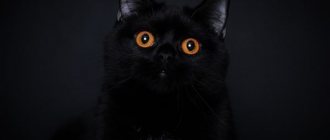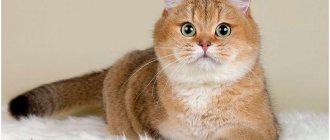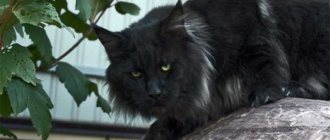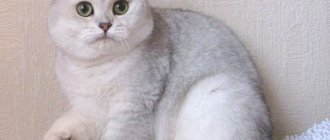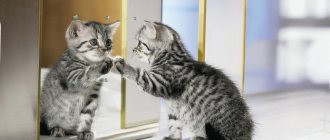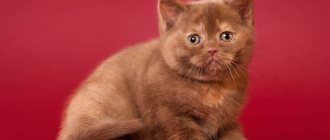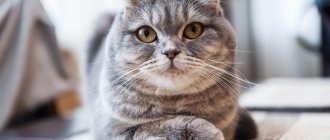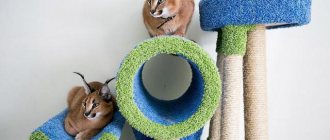Where does the British marbled cat come from?
Since the beginning of the 20th century.
British cats included not only plain blue animals, but also tabby cats with different shades on their fur coats. Thus, in 1901, American felinologists registered a Belle cat with a red tabby color. British marbled cats appeared as a result of crossing with other breeds
The consequence of two world wars was the almost complete extermination of the British breed, so breeders began to crossbreed pets with representatives of other varieties - Burmese, Russian Blues, Persians and Scottish. The result was the appearance of many varieties of British color while simultaneously preserving the breed characteristics (wide paws, protruding cheekbones, “plush” coat).
At the same time, among all the variations of the striped coat of the British fur coat, it is the marble color that is considered classic, occurring naturally. Zoologists are inclined to believe that the symmetrical darkening on the fur of catfish from Foggy Albion is an inheritance from wild Asian or African ancestors.
British tabby cat and its colors
British tabbies are animals that can boast of brightness and originality due to the unusual pattern formed on their fur. It is genetically determined that the pets of the presented breed must necessarily display a characteristic pattern after birth.
However, sometimes the agouti factor prevents the pattern from appearing; in this case, babies are born with a monochromatic coat. Only some kittens have intricate stripes, spots, or in certain areas the fur is less or more saturated. True, with age this all disappears and adult British cats become monochromatic.
In order for an animal to be accepted for exhibition, it must have clear tabby patterns. Otherwise, the pet will be considered “defective”. This will not take away beauty, but the “doors to society” will be closed.
BRITISH STRIPED COLOR (BRINCH, MACKERL)
The striped color of the British (British brindle tabby) must comply with all the same standards as the spotted one, only the pattern on the back and sides must have clear and uninterrupted stripes. In the color of a British Tabby Shorthair cat, the stripes should start at the spine and extend all the way to the paws. The stripes of a British brindle cat are narrow and frequent (and it is believed that the more often the better). Mackerel stripes (mackerel) should not intersect each other, be strictly vertical and always contrasting.
A brindle (striped) British kitten, even with very clear stripes, can “stretch” its color by adulthood and, if the stripes begin to be interrupted anywhere, the color is reviewed by experts and assigned - spotted. The full color of a British brindle kitten will be formed only by the age of one year (other tabby colors are not subject to such changes and most often do not change the appearance of the tabby pattern in adulthood).
British tabby cats are not as common as spotted cats, but more common than marbled cats.
The eye color of British tabby cats can be copper (golden, orange) or green (gold, occasionally silver).
Chocolate tabby British kitten: photo of California
TICKED BRITISH COLOR
The ticked color of the British cats is similar in appearance to the solid color, although it belongs to the Tibby color of British cats. The color should be even and only the upper part should look like “spraying”.
By spreading the fur, you can see that each hair has stripes. The undercoat corresponds to the color of the coat (chocolate, blue, lilac, etc.).
Of all the tabby markings in the ticked color of a British cat, only the letter “M” is present on the forehead and drawn curls on the cheeks. All other stripes, spots, rings on the tail and “necklaces” on the chest are rejected.
This color is very similar to the shaded and veiled one, only it has a higher intensity of the main color. Eyes are orange, golden or green.
Photo: golden ticked British tabby kitten BRI ny 25 64
Types of drawings
Tabby is not one specific pattern, as many people believe. There are several varieties of it, and all are considered standard. The pattern appears due to the A gene (agutti). A British female with the color formula “AA” gives birth to only patterned kittens, and with “Aa” the ratio of patterned kittens to plain ones is 50%. Cats with the formula “aa” will be monochromatic.
There are four main types of tabby patterns: ticked, striped, marbled, spotted.
Ticked (Abyssinian)
At first glance, it may seem that the British ticked coat is a solid color, but this is not the case. The color of their coat is not at all uniform: the whole body has barely noticeable stripes, spots or specks (there are “freckles”), slightly darker than the main tone of the British. The tip of the tail is usually dark. Eyes are golden or green.
Striped, brindle (mackerel)
The British tabby cat is the most popular cat available. The second name appeared due to the similarity with the color of the mackerel fish. The pattern is characterized by frequent narrow, clear stripes throughout the body, especially along the ridge. British tabbys are characterized by necklace-like lines on the chest and a broken stripe on the forehead, reminiscent of the Russian letter “M”. The British cat's full brindle coloration develops by the age of one year.
Classic (marble)
One of the most favorite colors among breeders of this breed is the marbled tabby. It is visible already from the birth of the kitten, it may merge slightly, but by two months it has a clear pattern. The body is covered with wide ornate patterns with clear outlines on the back, sides and vague ones on the abdomen and paws. The color of the pattern contrasts with the main shade of the Briton’s body – a kind of marble on silver.
Spotted (leopard)
A cat of the British breed with this coloring is similar to a representative of the wild - a leopard, but in miniature. Wide stripes are intermittent and represent spots of various sizes. Eye color: copper, green.
Genetics of tabby color
Thanks for the patterned colors should be the agouti gene (A), responsible for the presence of the pattern, and the tabby gene (T), responsible for the nature of the pattern.
There are four genes in total:
- Ta – ticked;
- T – striped or spotted;
- tb – marble.
Dominance:
- Ta dominates over T and tb colors;
- T is dominant over tb color;
- tb – recessive color.
Formula:
- AA - tabby, such an animal will always produce offspring with patterns;
- Aa - tabby, this animal can produce kittens with or without a pattern;
- aa is an animal without patterns, the offspring from it, accordingly, will also be monochromatic.
Spotted tabby (leopard)
With the help of the tabby gene and a set of polygenes, which seem to break the patterns on the cat’s body, a spotted color is formed. The spots contrast with the main color of the animal and are clearly defined, do not merge or intersect. The striped color becomes mottled even with little exposure to polygenes. This explains why spotted cats are much more common. The merle color is not so afraid of the effects of polygenes, because it will be considered spotted only if it is completely divided into clear spots of small sizes. By the pattern on the coat, it is most often noticeable from what color the spots were formed.
BSH n 24
Classic, blotched | marble tabby
It is a form of the tabby gene (tb). It is distinguished by its extraordinary beauty and rarity. The drawing is rich and contrasting. The butterfly-like pattern on the shoulder blades is one of the main distinguishing features. There are wide stripes along the ridge of the animal, and expressive large spots adorn the sides. It has a modification of marble, characterized in that it has a less pronounced middle and pronounced edges.
Red marble BRI d 22
brown tabby BRI n 22
Black marble silver ns 22
silver tabby BRI ns 22 64
Tiger, maskerel tabby (tiger)
This type of pattern is rare among tabby cats, but not as rare as merle. From head to tail there is a straight wide line, from which frequent, unbroken narrow stripes extend. The stripes tend to tear and then the tiger color turns into leopard, which is the reason for the rarity of the striped variety. Formed using the T gene.
Ticked tabby
The Ta genome is formed, which is dominant among all others. With this color there are practically no patterns, and the entire body is covered with ticked (striped) hairs. Despite the dominance of the gene, it is quite rare, being a gift from the Abyssinian breed, which does not currently exist. The value of this color is the intensity of the main tone of the animal’s coat and the undercoat of pleasant delicate shades.
BLH ns 25
ds 25 red silver ticked
Disadvantages of tabby color: “torn”, unclear and asymmetrical pattern, absence or non-closed rings on the neck. For light-colored animals, a brown or grayish undercoat color is unacceptable.
Eyes: Shades of orange or emerald eye color are acceptable, based on the basic tone of the British cat.
"Silver" and "gold" tabby
If you pay enough attention to the background, and not just the pattern, then the patterns on the wool take on a beautiful appearance. With the help of additional polygenes, you can give the undercoat a copper tone. Add a golden and unusual hue. And if you influence the pattern with the Silver gene, the tone will change to a pronounced pearl color and become silver.
Cons: There are many requirements for the golden and silver shade of the undercoat. So “gold” should have a color without any admixtures of brown and gray, and “silver” should have no yellow tint. The yellow discoloration that most often appears on the nose, paws and chest is called ruffism. It has been observed that breeds in which the fine “gold” silver contains rufisms, and in the pedigree with good “silver” the “gold” has an inappropriate undercoat color.
Eyes: “gold” must have green shades of eyes, “silver”, in addition to green, may have orange.
Moire or drawing?
When the Aguti gene does not have the proper effect on color, the cat's color becomes flat and without a pattern. The pattern on such cats is visible as moiré, despite the fact that at birth it was quite contrasting. A similar effect is observed in lion cubs and cubs of other feline species. There is a pattern in the genotype of any cat, but in order for it to appear, the influence of the Aguti gene is necessary.
Disadvantages: the disadvantages of cats without a pattern are the features of their patterned counterparts - incomplete moire, uneven coloring of the coat along the entire length. In adult cats, moire should be absent.
Eye color: copper, others are not acceptable.
There are polygenes that eliminate moire, because of this the moire pattern becomes either completely invisible or too bright, which misleads breeders. The cat appears to be tabby in color, which is not the case.
Distinguishing a pattern from a moire pattern is not as difficult as it seems. In tabby, the patterns are bright and contrasting, while in moire, they differ from the main type of coat by only a few tones.
SFL n 22 03
BRI h 22 – chocolate tortoise marble
Where did this color come from and why is it called that?
The question of where cats of such bizarre colors and different breeds come from will certainly arise if a British kitten appears in the house. The tabby color was most likely inherited by domestic cats from their wild ancestors, the Nubian Dun. It is from this species of cat that all our short-haired pets originated.
As for the term “tabby” itself, there are several versions about its origin. The most beautiful sounds like this. Somewhere at the beginning of the 17th century, silk fabrics, which were worth their weight in gold, were first brought to England. Their pattern was very similar to a cat's color and was called "tabbis". And when they later began to breed cats with a similar color, they were called tabby. In addition, cats of this color, like silk, were very expensive, since breeding them is extremely difficult - it is difficult to obtain the necessary pattern, shade and eye color that matches them.
Ticked tabby
The ticked or Abyssinian tabby color of the British cat can be confused with the monochrome color because it is not distinguished by patterns, but is nevertheless quite beautiful. The name comes from the Abyssinian cat breed, which has a similar color. The hair color should be even, and the top part of the hairstyle should look like a kind of “dust.” If you detect cat fur, you will notice that each hair has two colors. In this case, the undercoat of a British cat will correspond to the main color. Of all the tabby kittens, the kittens only have whorls on their cheeks and a scarab mark on their forehead.
If there are spots, rings, or a cloak that is not uniformly colored in two or three colors, the sample is discarded.
Abyssinian "rough" has apricot, brown and sandy yellow hues. However, the base of this color is black.
Health
The British Shorthair cat is not susceptible to hereditary diseases. She is in excellent health. However, this does not mean that vaccination and preventive examinations by a veterinarian can be neglected.
It must be taken into account that sexual and physical maturation in general occurs late in the British - around the age of four. It is at this age that kittens turn into adult cats: they show all the solidity and massiveness provided for by the standards. There is no point in sounding the alarm or suspecting dystrophy until this moment.
In comfortable conditions, a Briton lives on average 15 years. However, there are record holders in the breed whose age has exceeded 20. The reasons are simple: lack of stress, active cat life, balanced food and, of course, unconditional love. The well-being of the British largely depends on feeling like a member of the family.
Marbled Tabby
The marble tabby color in cats is the most beautiful, bright and complex. In addition, it is also the rarest due to difficulties in crossing - two marbled individuals can produce a tabby or spotted kitten. Such British cats wear three parallel stripes on the back, and large closed circles on the sides, inside of which there are brightly colored spots. Such a pattern should not intersect or be interrupted. In addition, a Marbled Briton must have the following markings:
- A pattern on the back of the head and shoulders resembling a butterfly.
- Patterns on the cheeks that start from the very corners of the eyes.
- "M" pattern on the forehead.
- The neck and chest are decorated with necklaces - the more, the better.
- There are spots on the tummy.
- The paws and tail must be ringed.
- The circles on the hips must be closed.
The color is rejected if the pattern is not contrasting enough, or if it shows residual faded stripes.
In a British cat, the merle color can be identified from birth. However, final alignment and clear drawing occur by two months. Therefore, if you want to get a real British harlequin, wait until this time, and do not adopt a kitten earlier.
SPOTTED TABBY, LEOPARD COLOR BRITISH
According to the standard, the spotted color of the British must contain the letter “M” on the forehead, “necklaces”, stripes on the paws, rings on the tail, spots on the belly, a contrasting pattern, eyeliner and nose.
The British spotted cat can also be called Spotted tabby or leopard, which, in principle, is the same thing. The color must invariably include: the letter “M” on the forehead, “necklaces”, stripes on the paws, rings on the tail, spots on the belly, a contrasting pattern, eyeliner and nose, all according to the standard. The spotted color is the most common of all tabby colors. The British spotted cat looks elegant and looks like a leopard, which is why it received this second name for the color. British spotted kittens can be born from parents of any tabby color. Eyes can be copper or green (green eye color is characteristic of golden and sometimes silver colors).
Photo of a British tabby kitten, black silver spotted color BRI ns 24
Required elements
The tabby color, despite many variations, has a number of unchanged elements:
- Ticking is actually the presence of the pattern itself. In this case, the hairs of the coat should be uniform in color down to the base.
- On the forehead of such cats there is always a pattern resembling the letter “M”, the so-called scarab sign.
- There should be a fingerprint-shaped spot on the back of the ear.
- The nose and eyes should be outlined. In this case, the color of the outline should be the same as the main color.
- The pattern, if there is one, must include the following elements: “necklace” - three closed stripes on the chest; “curls” on the cheeks; There are two rows of double spots on the tummy. All drawings should be clear and rich, and the coloring should be deep.
- There are also typical eye colors for tabbies - golden, orange and copper. If the color is silver, then the cat's eyes should be green.
If a Briton's color is blurred, and the patterns are cloudy and merge with the main color, then this is a defect. Most likely, one parent was a tabby and the other was a solid.
Color standard
The variety of cat colors never ceases to amaze. But there are standard distinctive features that are required for tabby cats:
- an “M” sign appears on the forehead between the eyebrows;
- the eyes and nose are edged with a thin line, thanks to which they stand out on the muzzle;
- on the stomach - individual spots placed in rows;
- on the neck there are continuous stripes, similar to a necklace;
- paws and tail are covered with ring-shaped stripes;
- the contrasting pattern is clear and bright;
- pets with a silver tint of fur have green eyes;
- other tabby cats have warm-colored eyes (lemon, copper, orange, brown, amber).
With all these standard characteristics, it is impossible to find two cats with exactly the same pattern.
Originality, brightness, uniqueness and originality of color - these are the characteristics that are valued by knowledgeable lovers of tabby-colored pets.
Types of colors
Selection work on representatives of the British breed, involving various bloods, has led to a variety of both colors and breed types. If initially the British had short hair with a thick undercoat, then crossing with the Persian cat made it possible to obtain semi-long-haired animals. The colors of British longhair cats correspond to the colors of shorthair cats.
Many people only think of Britons as smoky, blue or tabby cats and don't even realize how many colors the breed has. Even a pair of quite ordinary parents can produce a kitten of a rare color.
To organize the variety of colors of British cats, they are divided into types and groups according to color, pattern and method of pigmentation.
Types of colors of British cats:
- solid (or plain);
- typed: smoky, veiled, shaded;
- gold;
- silver;
- tortoiseshells;
- color point;
- particolors: harlequin, bicolor, van, mitted;
- tabbies: spotted, striped, marbled, ticked.
A table of the colors of British cats will help you imagine all the diversity.
BRITISH SHORTHAIR TABBY CAT: VARIETIES OF COLOR PATTERNS
Shorthair British tabby cat, may be one of the following color subspecies:
- ticked;
- spotted (leopard);
- striped (brindle);
- marble.
Let's look at all types of colors schematically.
Possible tabby colors
Among tabby cats, gray and silver cats predominate with markings of a wide variety of colors: lilac, chocolate, blue, smoky black, reddish. But this does not mean that other tabby colors are rare. In the table below we look at the main variations of tabby color.
Table 2. Possible flower combinations for tabby color
| Color name | Marking color | Leading coat shade |
| Amber | Smoke black | Peach |
| Black silver | Deep black | Silver |
| Blue | Gray dust | Ivory |
| Blue silver | Grey | White |
| Bronze | Dark chocolate | Warm cream |
| Brown | Black night | Gray with brown or copper fade |
| Cameo | Fiery red | Warm ivory |
| Caramel | Milk chocolate with light color | Beige |
| Coal | Black chocolate | Smoke gray |
| Chestnut | Bright brown | Cream with possible orange undertone |
| Chocolate silver | Milk chocolate | Light blue silver |
| Cinnamon | Light chocolate with red flecks | Several shades lighter than the drawing |
| Golden cinnamon | Cinnamon | Ivory |
| Cream | Bright cream | Pale cream |
| Cream silver | Cream | Delicate silver |
| Faun | Light beige with cinnamon | Pale beige |
| Gold | Black | Milk chocolate with light color |
| Delicate amber | Grey, light gray | Tender peach |
| Lilac | Gray with splashes of pink or blue | Light cream |
| Peach | Brown with pink | Delicate cream |
| Red | Fire orange | Several tones softer than the original pattern |
| Purple silver | Lilac | Light silver with lilac splashes |
| Silver | Deep black | White |
It is worth noting that colors may vary depending on the design. Thus, spotted patterns are often presented in warm colors: golden, chocolate, wheat, brown, reddish, red. The classic type combines contrasting patterns of dark stripes on a light background: cream, yellowish, gray. The basis for dark striped patterns is silver and gray. The ticked type offers almost all possible colors. You can read about the mechanisms of genetic inheritance of pigments from cat to cat below.
Pigments and options for their transmission
In addition, the pattern may vary depending on the breed.
Table 3. Tabby color options for different breeds
| Breed | Color name | Marking color | Primary coat color |
| California speckled | Bronze, coal, snow leopard, royal glitter | Bronze - chocolate, charcoal - dark chocolate, snow leopard - black, glitter - brown with black | Bronze, snow leopard - ivory, coal - dark gray, glitter - gold |
| Egyptian Mau | Mottled Bronze, Smoke Spots, Mottled Tin | Bronze – chocolate, haze – dark chocolate, tin – gray-black | Bronze - cream, haze - dark gray, tin - silver |
| Ocicat | Golden cinnamon, sienna, spotted tawny | Cinnamon – chocolate, sienna – beige, tawny – dark chocolate | Cinnamon, sienna - ivory, tawny - red |
| Australian smoke | Golden haze, peach | Haze - golden chestnut, peach - brown with a hint of pink | Haze is several shades lighter, peach is a light cream |
| Bengal cat | Leopard, snow | Leopard - red markings in black circles, snow - cream markings in black circles | Leopard – yellow cream, snow – white |
Tabby cats with a rarer color are valued higher - because of this, they can cost more than their counterparts.
Tabby Color Genetics
Tabby patterns are caused by three different gene loci and one modifier.
The Agouti gene, with its two alleles A and a, controls whether or not the Tabby pattern is present. The dominant A expresses the basic Tabby pattern, and the recessive "non-Agouti" or "hypermelanistic" allele indicates its absence. Solid (black or blue) cats have an "a" combination that hides the striped pattern, although traces of it can sometimes be seen (called a "ghost stripe"). This basic pattern, whether classic, tabby, spotted or ticked, is most easily distinguishable in bright light during the early stages of a kitten's development and into adulthood on the tail.
However, the Agouti gene only controls the production of black pigment, so a cat with the O allele (responsible for orange or red color) will still express a tabby pattern. As a result, both red cats and red spots on cat skins will always display striped patterns.
The tabby cat's primary pattern gene is dominant, so it is a cat with the Mc genotype (mc or Mc) - mackerel.
The "Mc" set establishes the basic pinstripe pattern (striped mackerel) that underlies the coat. Mc is the wild type Tabby gene. Classic tabby cats are animals that have two copies of the recessive mc, so they are carriers of the mc/mc allele. This is a recessive mutant (not wild type) mc gene that produces the spotted pattern and appears in the cat as the classic pattern of thick stripes with a bullseye pattern on the sides.
The spotted gene is directly related to the Mc gene, it “breaks” the Tabby stripe lines, turning them into spots. It is also dominant, designated Spotted or Sp (sp or Sp). Sp together with Mc and Agouti make up various combinations - mc and Mc/Mc and A/ a and A/A.
The Ticked tabby pattern is at a different gene locus than the Mackerel and Classic tabby patterns, and is epistatic to (influenced by) other patterns. The dominant Ta/ta mutation masks any other Tabby pattern, creating a striped background or agouti stripe with virtually no lines. If the Ticked tabby pattern gene is present, any other Tabby pattern is masked.
Cats homozygous for the marked allele (Ta/ta) have fewer medallion defects than cats heterozygous for the marked allele. When a cat of this genetic makeup is selectively bred for lack of faults and broad stripes on the hair shaft, the resulting pattern is called shaded.
There are additional alleles and even additional genes influencing Tabby patterns that have also been identified and postulated.
The three most common alleles in order of dominance are Ta, the allele for ticked patterns as in the Abyssinian type, Tm, for tabby mackerel, and the recessive tb for classic.
The Ta allele is dominant over Tm and tb.
A cat with the Ta allele will express a ticked tabby pattern (only with stripes on the paws if there is only one copy and none at all if there are two), and a cat with two tb alleles will express the classic stripe pattern.
The wild type is the mackerel (the stripes look like thin fish bones and can break up into linear markers or spots), the most common variety is the classic striped pattern (wide stripes, curls and spirals of dark color on a pale background, usually with bullseye on the side) and, Perhaps the most famous of the less common tabby cat designs is the “swoosh.”
Classic tabbies are most often found in Iran, England and the lands that were once part of the British and Persian empires. The gene responsible for differentiation pattern formation was named transmembrane Q (Taqpep), which also underlies the coat color of the king cheetah.
King Cheetah
Other pattern modifier genes are responsible for creating different types of spotting, many of which are variations of the basic mackerel or classic pattern. There are also hypothetical factors that influence the timing and frequency of Agouti shifts, affecting the width of its band and the quantity and quality of alternating eumelanin and pheomelanin lines on individual hairs.
There is also a gene, not yet identified but believed to be related to the Agouti gene, in the Chausie breed that produces silvery black fur similar to the Abyssinian. It is assumed that the "gray" phenomenon is inherited from the hybridization of the domestic cat with the House (Felis chaus).
Black Chausie
The pigment gene, I/i, is also inhibited. The dominant allele (I) produces hairs with tips of a different color, which are completely colored only on it and have a white base. This allele appears to interact with other genes to cause varying degrees of coloration, ranging from dark-tipped silver tabby to lightly shaded silver and silver chinchilla. The inhibitor gene interacts with the non-Agouti genotype (I-aa) to produce a color known as smoke.
The homozygous recessive genotype combined with the agouti gene (iiA) produces the Tabby's coloration, which can range across the spectrum from a deep-patterned brown tabby to a light yellowish, slightly tinted golden or chinchilla gold. Orange cats with the inhibitor (IO) gene are commonly called "cameos".
Still, the Tabby pattern exists thanks to the Agouti gene. Their stripes have an even distribution of pigment, while the background consists of banded hairs. Tabby cats usually have the following characteristics:
- Mark in the form of the letter "M" on the forehead. Visible in marked tabby cats, but difficult to distinguish in darkened silver and golden animals.
- Thin “pencil” lines on the muzzle. Clearly visible in tabby cats, but more difficult to notice in darkened silver/golden pets.
- Black "eyeliner" and white or pale fur around it.
- Pigmented lips and paw pads.
- Pink nose with darker pigment.
- Ring “girth” of the body, legs and tail. The stripes on the torso disappear when the color is ticked.
The main thing is love and affection
Cats of this breed are very sensitive and vulnerable. They definitely need to be petted, otherwise they get offended and worried. Simply feeding is clearly not enough. You need to take her in your arms and say kind words. They feel everything. Sometimes, even too much.
However, these cats will never impose themselves and get in the way
The owner himself must take the initiative and show attention to the pet.
Tabbies are very friendly and trusting. This breed is an excellent choice for families with small children. Cats will patiently endure any treatment from their little owners and will never show even a shadow of aggression towards them, not to mention extending their claws.
Representatives of this breed get along well with other pets. They can make excellent friends even with a pet rat, hamster or parrot, if there are any in the house.
Tabby (tabby) color of a British cat
The group of tabby (tabby) colors unites all cats that have a pattern in their color.
Presumably, the name “tabby” itself comes from the type of design (“tabbis”) on precious silk fabrics brought to England in the 17th century from the countries of East India.
Genetically, all cats (and male cats) are carriers of some kind of pattern - all are “tabbiks”, however, in the genetic makeup of cats there is a so-called “agouti” factor, which either allows the pattern to open - then it becomes visible, or does not allow it, then we see the animal has a solid color. A visual confirmation of this is the shadow pattern in small kittens of a solid color. Kittens “moiret”, stripes and spots are visible, which disappear with age. But, if the “agouti” factor allows the drawing to open up, the result is a “tabbik” - a patterned cat.
Varieties of drawing
A tabby cat has its own pattern classification. The breed standards define the following main color types:
- Brindle or striped (mackerel);
- Leopard or spotted;
- Marble.
Abyssinian specimen
This color was named after the color of Abyssinian cats, since it is most often found in this breed. It is characterized by the absence of a pattern as such, but the ticked hairs give a special shine. The main color is black and each hair is lightened in waves. At the same time, there is a play of colors: sand, cream, apricot.
Features of character and behavior
The British cat, massive and clumsy, is actually very, very active. It’s just that he prefers sleep to any active activity. The British sleep 20 hours a day, sometimes without stopping to eat.
Up to 3-4 years The British are not yet fully formed, both physically and psychologically. At this age, they are, in essence, still kittens with appropriate behavior - active and mischievous. Then the kitten becomes much calmer.
The breed is characterized by absolute self-sufficiency. The British Shorthair cat itself determines the rhythm of life, the time for affection and, especially, for games. Shows independence from early childhood. Even a small kitten has sacred knowledge of its rights. The most important thing is not to waste time. Kittens up to one year old are amenable to suggestion and education. After - no.
Soft and independent Britons have their own opinion about everyone. The kitten will choose a place to sleep himself. The owner’s task is to equip it. When dealing with a Briton, you must remember: he has remarkable intelligence and memory. Reviews indicate that from childhood the kitten demands respect for its person and really does not like noise.
You will have to forget about closed doors in the apartment: this will cause shock in an absolutely calm cat, even to the point of depression. Ideally, of course, the British should be able to roam freely. Then neither the cat nor the owner will experience any shocks.
The British Shorthair cat is non-aggressive, but will not allow itself to be offended. She is unobtrusive and rarely talks out loud about her feelings. If a Briton wants to eat, this will be expressed in a silent picket next to the cup.
Kittens get used to the family and are sincerely attached to the owner, but they can do quite well without his company.
Who is suitable for a British tabby?
If you consider the main qualities of a pet to be affection and the ability to cuddle it, then this breed is not for you.
British cats have an independent character and live “on their own.” They are not attached to any family member. They are not afraid of loneliness, and therefore are suitable for business people who stay at work for a long time.
The British do not require additional education. They are clean, and therefore the cat's litter box will have to be changed more often than usual: these clean people can ignore the dirty toilet and relieve themselves in another place. But in general they rarely bully.
Their coat does not require special care. Animals take care of their hygiene independently.
The British tabby dog will be a great friend for a child. However, he will not accept excessive affection from him: British cats do not like excessive attention to their person, and will not sit on your hands. Rarely shows aggression, and therefore can get along even with dogs. British kittens are very playful up to a year old, but with age they become lovers of lounging on the sofa.
Their motto in life becomes the phrase: “Once you’ve eaten, you can sleep.” If you sleep, you can eat.”
With such a lifestyle, it is important for the breeder to ensure that the pet does not gain excess weight.
Conclusion
A large selection of cat color palettes will suit everyone's tastes. Britons do not require much care and will make an excellent friend and pet.
https://youtube.com/watch?v=Eifs1WQ8EKQ%3F
Breeds with tabby color
Since tabby color is considered the most common color in cats, there are many breeds that recognize the tabby color. Pets with this color can take part in exhibitions, but each breed has its own requirements for tabby coloring.
British cat
Kittens with a striped pattern are born from parents with the same color. At least one parent must be tabby for the kitten to be tabby at birth. It is noteworthy that at birth the color is contrasting, and during the growth period the color is slightly blurred. Compliance of coat color with the standard can only be fully considered when the pet is one year old.
Basic standard requirements regarding tabby colors for British cats:
- the presence of a pronounced letter M in the forehead;
- there should be stripes on the chest that resemble a necklace;
- there should be stripes on the limbs;
- the tail should also have ring-shaped stripes;
- on the belly, spots can be located in one or two rows;
- there should be light spots on the outside of the ears;
- The tabby pattern should be contrasting;
- eyes and nose should have eyeliner in the same tone as the main coat color.
Eye color must correspond to the standard of the basic coat shade. For example, a blue British tabby dog should have golden or copper eyes. British red tabby cats have the same eye color. Silver tabbies are distinguished by the color of their iris; the eyes of these British cats are brilliant green or hazel.
Copper-brown tabbies with black markings boast copper or gold eyes. Smoky tabbies have copper eyes. Golden Britons always have green eyes. Blurry patterns in cats may result in disqualification. A fuzzy pattern occurs in kittens born from matings where one parent was tabby and the other was solid.
The character of British kittens does not depend on color and the presence of marbling or spotting. Pets of this breed do not require special coat care, so they are suitable for working and always busy people. The British are smart and quickly master the litter box, so there will be no problems with toilet training. Cats of this breed are accustomed to restraining their emotions, so they will not meow unnecessarily. They love human attention and a calm environment in the house.
Siberian cat
The Siberian cat is characterized by a wild coat color with stripes or spots. The main color of the coat can be any, but most often it is a brown-gray color, which allows for good camouflage in the wild. The letter M is clearly visible on the muzzle, and the eyes are usually light yellow or greenish. Siberians have several varieties of tabby:
- The classic color has a rich, clear pattern formed by wide stripes. On the limbs, ring-shaped stripes are visible, rising upward and turning into stripes on the body. Ring stripes are also visible on the tail. There are characteristic stripes on the neck and chest that make up a kind of necklace. The standard allows for white spots in the form of buttons or medallions.
- The brindle coloring of the coat is formed by thin, well-drawn lines. Along the spine, the pattern formed by lines resembles a saddle. White markings (buttons, medallions) are allowed.
- The tabby pattern is silver, blue, silver-blue and brown with a cream or red background.
- The spotted tabby is formed by spots of various sizes and shapes. A stripe runs along the ridge, ending at the end of the tail. There is a ring-like pattern on the paws and tail.
The peculiarity of Siberian cats lies in the special structure of their fur coat. The outer coat does not allow moisture to pass through, and the undercoat is so warm and thick that it allows it to survive even in extreme cold. On the paws, the spaces between the toes are filled with hair, which facilitates movement on ice and snow.
External severity and massiveness creates the impression of a heavy and complex character in the pet. But this is not entirely true. Siberians treat the owner and his family members with respect, but at the same time prefer to maintain independence. These animals do not harbor resentment or anger. Suitable as companions for lonely people. Families with children can also have such pets, but the child should not squeeze or offend him when interacting with the cat.
Siberian cats are born leaders. Therefore, if several pets live in a family, they will be happy to lead the cat pride. The love of hunting can lead to the fact that smaller pets (rats, mice, hamsters) are under threat of extermination. You can try to teach a Siberian to live peacefully next to a mouse in a cage. Cats are smart and quick-witted, so they will be able to understand the essence of the ban.
Maine Coon
The Maine Coon is characterized by 3 types of patterns:
- marble;
- striped;
- spotted.
Like all tabby cats, Maine Coons must have an M on their head and their eyes must be clearly outlined. Each pet's hair has stripes, for which the Agouti gene is responsible. Pets with a marbled color have wide stripes on the sides arranged in a spiral. Vertical stripes on the body and spotting in the belly area are characteristic of Maine Coons with brindle tabby color.
Interrupted stripes resembling spots are typical for spotted tabby colors. Silver tabbies have a color problem. Pets may develop yellow spots on their fur. Silver Maine Coons with tabby coloring should have green eyes. Solid colors of Maine Coons are called solid.
The color of the Maine Coon's eyes should be in harmony with the color of the coat. The color of the eyes of pets can be green, golden, and in light-colored animals - blue. Maine Coons are quite impressive cats in size. Their weight can reach 8-9 kg, and their height is 25-40 cm. Sterilized pets are prone to gaining excess weight, their weight can exceed 10-12 kg. The total length of the body including the tail is about 130 cm.
Maine Coons are considered a good option for pet keeping. These cats are independent, so they will not bother their owner unnecessarily. They are active and playful, children will not be bored with them. Maine Coons are not aggressive and are not prone to vindictiveness. They are patient, smart, delicate. There are no problems with litter box training.
Pets find a common language not only with people, but also with other pets (dogs, cats). The natural instincts of a predator are perfectly developed in representatives of this breed. Cats will cope not only with mice that have climbed into the closet, but also with rats that eat food supplies in the underground.
Up to 5 years of age, Maine Coons are characterized by increased activity; older individuals get used to the sofa lifestyle. But a running mouse will be caught by a pet at any age.
Sokoke
The breed was officially recognized in 1992. The first representatives were found in Kenya and then taken to Denmark. The Sokoke breed is characterized by a marbled tabby coat color: on a basic gray background there is a dark brown or deep black pattern. The fur coat of representatives of this breed is incredibly shiny. The fur is short, lying close to the body. There is a black mark on the tip of the tail.
By nature, pets are distinguished by curiosity and tirelessness. They love games and conversations. The cats are affectionate and become attached to their owners. Capable of existing with other pets in peace and harmony. It is best if the second pet is a kitten of the same breed. Sokoke even gets along with dogs. Cats are not afraid of water, they love water treatments and will not refuse to swim in a pool or bath. They quickly climb trees.
Scottish cat
The tabby color of Scottish cats is characterized by the letter M on the forehead, eyeliner and nose, encircling lines of the necklace on the neck and chest, rings on the paws and tail. The coat color of Scottish pets is classified depending on:
- Pattern type: brindle, marbled, spotted.
- Color combinations: silver with black pattern; silver-blue with light undercoat; red with a light red base and a bright brick-red pattern; chocolate with copper base and black design lines; cream with a light cream base color and beige stripes; cameo tabby – there are red stripes on a white background.
The eyes can be of different colors, but must match the main color of the coat. Pets have yellow, amber, blue and even emerald eyes. Divergence of eyes is observed in blue and white animals.
The character of Scottish cats does not depend on their folded ears or coat color, but rather on the individual characteristics of the pet. Positive aspects of the Scots character:
- good nature;
- relative tolerance for children's pranks and bullying;
- optimistic attitude;
- low aggressiveness;
- quick adaptation to new conditions;
- lack of rancor;
- easy to train;
- getting along with other pets.
The disadvantages include the following:
- Capriciousness and willfulness. Pets love to be the center of attention.
- Curiosity. They climb into imaginable and unimaginable areas of the house, open drawers of a table, closet, chest of drawers, they can be found in a saucepan or in a bag with flour, sugar, potatoes.
- Attachment to the owner sometimes turns into obsessive following and wandering underfoot, which causes irritation and makes it difficult to quickly get ready for work.
- Love of constant meowing. Cats of this breed are too talkative, so they accompany all their movements with the words “meow” or “purr”.
Persian cat
The tabby color of the Persian cat varies, but only three shades are recognized: brown, silver and orange. Pets' irises can be copper, greenish or hazel in color and should be combined with the main shade of the coat. Persian kittens have long, problematic hair that requires proper care. These pets are not adapted to life in the wild.
Persians are peaceful and therefore make excellent friends with children and adults. Pets do not show aggression, even if the child begins to actively squeeze the animal. The cat will prefer to hide away, but will never let out its claws. Compared to other breeds, Persian cats are somewhat passive. But with the right approach, you can always run and play with them.
American Bobtail
A short-tailed breed bred in the mid-20th century in the USA. The first representative of the breed was the homeless child Yodi - a kitten with a short tail. The American Bobtail's coat can be short or medium length. Any color is allowed, but tabby in any variation is considered the most beautiful.
American-born Bobtails are very intelligent and incredibly affectionate. They become attached to a person and are very sad during separation from him. Pets of this breed love driving, so they are popular with truck drivers and people who are constantly behind the wheel. They do not show aggression towards other pets and get along well with dogs and cats.
Hunting instincts are well developed. Animals can catch not only mice, but also butterflies and birds that fly into the window. Pets are playful, love outdoor games, hide and seek, and catch up. A candy wrapper on a string is a great pastime for them. Bobtails rarely talk, but if they like something, they cannot do without loud purring.
Pixie bob
The breed, which has only tabby coloring, was recognized in 1998. The history of the breed began 13 years before official recognition. In the state of Washington, they tried to crossbreed the bob-tailed pet Pixie with polydactyly with animals that have the same body structure features.
This is where the name came from: Pixie is the first cat to take part in the formation of the breed, bob indicates an unusually short tail. Pixie-bob eyes can be greenish or golden.
The breed is considered the property of Americans and representatives are prohibited from being exported outside the States. Cats participate in exhibitions organized in their homeland. Pixie-Bob kittens have an easy-going character. They are non-aggressive, but will not allow themselves to be offended. The appearance of strangers in the house is treated with caution. Cats get along well with children, never offend children, and become not only their friends, but also their protectors.
Balance and calmness are the main character traits of pixie bobs. Cats of this breed love to hunt. The water-repellent properties of wool allow pets to live in cold and damp conditions. Pets are very smart, so they can perform simple tasks, for example, fetching a toy or slippers in their teeth.
